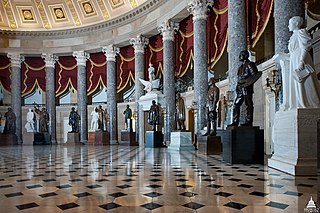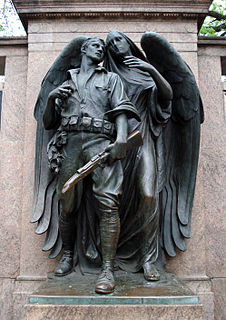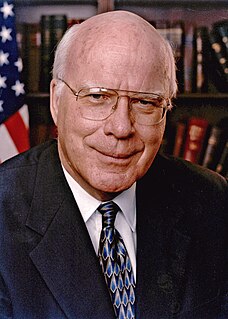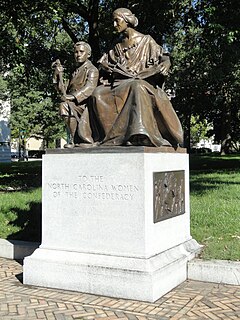
The National Statuary Hall is a chamber in the United States Capitol devoted to sculptures of prominent Americans. The hall, also known as the Old Hall of the House, is a large, two-story, semicircular room with a second story gallery along the curved perimeter. It is located immediately south of the Rotunda. The meeting place of the U.S. House of Representatives for nearly 50 years (1807–1857), after a few years of disuse in 1864 it was repurposed as a statuary hall; this is when the National Statuary Hall Collection was established. By 1933 the collection had outgrown this single room, and a number of statues are placed elsewhere within the Capitol.

James Zachariah George was an American lawyer, writer, U.S. politician, Confederate politician, and military officer. He was known as Mississippi's "Great Commoner."

Henry Augustus Lukeman was an American sculptor, specializing in historical monuments. Noted among his works are the World War I monument in Prospect Park, Brooklyn, the Kit Carson Monument in Trinidad, Colorado and the Stone Mountain Confederate Memorial in Georgia.

The 61st United States Congress was a meeting of the legislative branch of the United States federal government, composed of the United States Senate and the United States House of Representatives. It met in Washington, DC from March 4, 1909, to March 4, 1911, during the first two years of William H. Taft's presidency. The apportionment of seats in the House of Representatives was based on the Twelfth Census of the United States in 1900. Both chambers had a Republican majority.

The 38th United States Congress was a meeting of the legislative branch of the United States federal government, consisting of the United States Senate and the United States House of Representatives. It met in Washington, D.C. from March 4, 1863, to March 4, 1865, during the last two years of the first administration of U.S. President Abraham Lincoln. The apportionment of seats in the House of Representatives was based on the Eighth Census of the United States in 1860. The Senate had a Republican majority, and the House of Representatives had a Republican plurality.

The 44th United States Congress was a meeting of the legislative branch of the United States federal government, consisting of the United States Senate and the United States House of Representatives. It met in Washington, D.C. from March 4, 1875, to March 4, 1877, during the seventh and eighth years of Ulysses S. Grant's presidency. The apportionment of seats in the House of Representatives was based on the Ninth Census of the United States in 1870. For the first time since the American Civil War, the House had a Democratic majority. The Senate maintained a Republican majority.

Charles Henry Niehaus, was an American sculptor.

The 45th United States Congress was a meeting of the legislative branch of the United States federal government, consisting of the United States Senate and the United States House of Representatives. It met in Washington, D.C. from March 4, 1877, to March 4, 1879, during the first two years of Rutherford Hayes's presidency. The apportionment of seats in the House of Representatives was based on the Ninth Census of the United States in 1870. The Senate had a Republican majority, and the House had a Democratic majority.

The Dean of the United States Senate is an informal term for the senator with the longest continuous service, regardless of party affiliation. This is not an official position within the Senate, although customarily the longest-serving member of the majority party serves as president pro tempore.
The Piccirilli brothers were an Italian family of renowned marble carvers and sculptors who carved many of the most significant marble sculptures in the United States, including Daniel Chester French’s colossal Abraham Lincoln (1920) in the Lincoln Memorial, Washington, D.C.

The Hall of Columns is a more than 100-foot-long (30 m) hallway lined with 28 fluted columns in the south wing extension of the United States Capitol in Washington, D.C. It is also the gallery for 18 statues of the National Statuary Hall Collection.
Roman Bronze Works, now operated as Roman Bronze Studios, is a bronze foundry in New York City. Established in 1897 by Riccardo Bertelli, it was the first American foundry to specialize in the lost-wax casting method, and was the country's pre-eminent art foundry during the American Renaissance.

Francis Asbury, also known as the Francis Asbury Memorial, is a public equestrian statue, by American artist Augustus Lukeman, located at 16th Street and Mt. Pleasant Street, Northwest, Washington, D.C., in the Mount Pleasant neighborhood.

The Daniel Boone Bicentennial half dollar was designed by Henry Augustus Lukeman and minted during the 1934, commemorating the 200th birthday of frontiersman Daniel Boone. The obverse depicts Boone while the reverse depicts a frontiersman (Boone) standing next to an Indian Chief in front of a stockade on the left and the rising Sun on the right.

Jefferson Davis, created by Henry Augustus Lukeman, is a bronze sculpture of Jefferson Davis – a U.S. Senator, U.S. Secretary of War, plantation owner and the only President of the Confederate States of America – commissioned by the U.S. State of Mississippi for inclusion in National Statuary Hall Collection at the United States Capitol's National Statuary Hall, in Washington, D.C.. The statue was controversial at the time of its unveiling and there have been efforts to remove it from the Capitol from 2015 onward.

Zachariah Chandler is a statue depicting the politician of the same name by Charles Henry Niehaus, formerly installed in Washington, D.C., representing the U.S. state of Michigan in the National Statuary Hall Collection. In 2011, the statue was relocated to the atrium of Lansing's Constitution Hall, and replaced by another depicting Gerald Ford.

The 83rd Massachusetts General Court, consisting of the Massachusetts Senate and the Massachusetts House of Representatives, met in 1862 during the governorship of John Albion Andrew. John Henry Clifford served as president of the Senate and Alexander Hamilton Bullock served as speaker of the House.

There are several works of art in the United States Capitol honoring former leaders of the Confederate States of America and generals in the Confederate States Army, including eight statues in the National Statuary Hall Collection, busts and portraits.

The Monument to North Carolina Women of the Confederacy was installed in Raleigh, North Carolina, United States in 1914. It was located in the surrounds of the North Carolina State Capitol, until its removal on June 21, 2020 during the protests following the murder of George Floyd.
















